#green humphead parrotfish
Text
Animal of the Day!
Green Humphead Parrotfish (Bolbometopon muricatum)
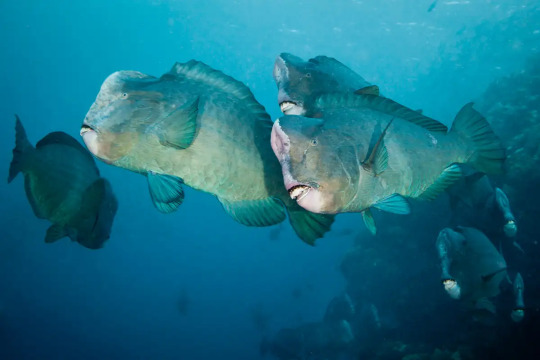
(Photo by Mark Priest)
Conservation Status- Vulnerable
Habitat- Indo-Pacific Ocean; Red Sea
Size (Weight/Length)- 75 kg; 1.5 m
Diet- Algae; Coral
Cool Facts- The green humphead parrotfish is the largest species of parrotfish and the largest, reef-dwelling, herbivorous fish. As they age, their forehead increases in size and their teeth plates become exposed. These fish have the extremely important job of eating dead coral and removing algae from living ones. While huge schools of up to 75 parrotfish can result in bioerosion by eating too much coral, they mostly keep reefs thriving. Unfortunately, their schooling behavior makes them easy targets for fishermen and has led to overfishing. Multiple atolls, reefs, and islands have been protected from fishing and allows the green humphead parrotfish to thrive.
Rating- 12/10 (Can produce 530 tons of force with their mouth alone.)
#animal of the day#animals#fish#marine creatures#parrotfish#monday#september 25#green humphead parrotfish#bumphead parrotfish#biology#science#conservation#the more you know
191 notes
·
View notes
Text
Daily fish fact #697
Green humphead parrotfish!

It is the largest and heaviest of the parrotfishes, growing to be 1.3 meters long (~4'3'') and weighing up to 46 kilograms (100 lbs). They develop their bulbous hump as they mature, ramming it into coral to break them down into smaller pieces to eat.
#fish#fish facts#fishfact#fishblr#marine biology#marine life#sea creatures#marine animals#sea animals#sea life#biology#zoology#parrotfish#green humphead parrotfish#bumphead parrotfish#giant parrotfish
89 notes
·
View notes
Text
Wet Beast Wednesday: parrotfish
Which fish hangs out on a mermaid pirate's shoulder and repeats what she says in a high-pitched voice? The parrotfish, of course. Or at least in fiction they should (certainly will in my D&D world). But even in real life, parrotfish are still pretty interesting.

(Image: a common parrotfish (Scarus psittacus) seen from the side in front of rocks and corals. It is a brightly-colored fish, mainly light blue but with patches and stripes of yellow and pink on the fins. Its mouth is open, revealing what appears to be a beak. End ID)
Parrotfish are fish famous for their mouths and eating habits. There are about 90 species known. While they were historically considered their own taxonomic family, they have since been reclassified a subset of the wrasse family and there is still some debate on how to classify them. Most species are on the smaller size, but a few can get very large. The largest species is the green humphead parrotfish (Bolbometopon muricatum) at 1.5 meters (4.9 ft) and 75 kg (165 lbs) while the smallest species is the bluelip parrotfish (Cryptotomus roseus) reaching 13 cm (5 in). I could not find an average weight for the bluelips. What makes parrotfish really stand out visually is their colors and their mouths. Most species are very brightly colored, with distinct markings and males are usually more brightly colored than females. Their mouths are dominated by what appear to be beaks, which gave them their common name. These beaks are actually made of approximately 1,000 teeth arranged in 15 rows. As the teeth wear out, they drop off and are replaced by the row behind them. The teeth are made of fluorapatite, the second hardest biomineral int the world. To support their hardness, the fluorapatite crystals that make up the teeth are woven together in a structure very similar to chainmail, resulting in very hard teeth that measure in at a 5 on the Mohs scale of hardness. For reference, iron is a 4 and higher numbers are harder. The teeth can also handle 530 tons of pressure. You could put the weight of 200 black rhinos on a tooth and it would be fine. The beaks are powerful enough to bite through rock. Which is what they use it for, but more on that below. Another unusual feature of parrotfish is how they sleep. Some species make their own sleeping bags, which would be adorable if they weren't made of mucus. The mucus is produced using glands in the gills and looks like a transparent bubble. The fish sleeps in the mucus cocoon and when it wakes up, it eats the cocoon. There have been several proposed benefits of the cocoon. It contains chemicals that harm skin parasites while also providing a barrier that keeps new parasites from reaching the fish. It also likely blocks the fish's scent, helping it hide from predators.
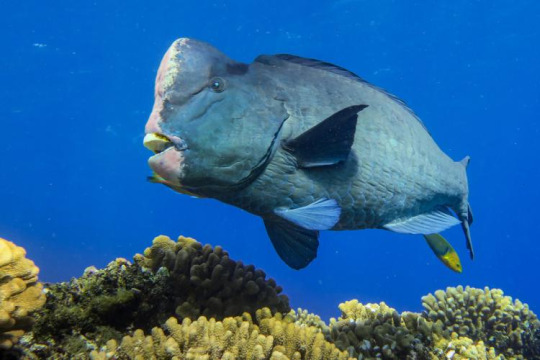
(Image: a green humphead parrotfish (Bolbometopon muricatum) swimming over yellow coral. It is large and mostly a uniform green color, except for the front of its head, which is pink. It has a large, fleshy lump on the top of its head. End ID)
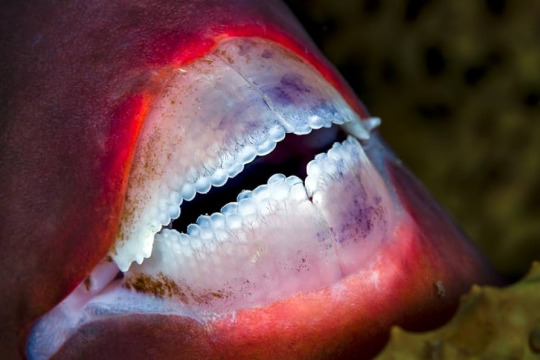
(Image: a close-up of a parrotfish's beak. The top and bottom beaks are divided into two halves, left and right. The beak is bade of small, circular teeth that overlap each other. End ID)
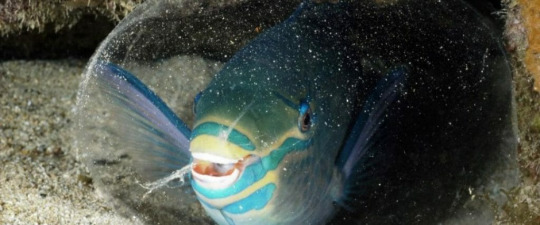
(Image: another common parrotfish seen from the front. It is inside of a mucus cocoon, which appears as a transparent bubble around the fish. Bits of sand dot the cocoon's surface. End ID)
Parrotfish live worldwide, though the majority of species are found in the Indo-Pacific. They live in warm, shallow waters with lots of rocky reefs, especially coral reefs. They use those powerful teeth to eat and what they eat most is algae. There are three main types of feeding behavior: excavating, scraping, and browsing. Excavators bite into rocks to get their food, scrapers crape food off of the surface of the rocks, and browsers go after larger food sources like seagrass and sponges. Some of the larger parrotfish species also make coral a large part of their diet. When they eat, they naturally get rock in their mouths, moreso in excavators. Because their food clings to the rock, spitting the rocks out would deny them food. Instead, parrotfish use pharyngeal teeth set in their throats to grind the rock into sand, which then passes through the digestive tract. When it exists the digestive tract, it is in the form of fine grains of rock. Or to put it another way, parrotfish eat rock and poop sand. A single parrotfish can produce up to 40 kg (88lbs) of sand yearly, and bigger species can produce even more than that. The process of rock being broken down by living things is called bioerosion and parrotfish are one of the most famous sources of bioerosion. The sand they produce can serve as the basis for new growth of coral or other species and helps reinforce nearby islands. In places like Hawai'i, the Caribbean, and the Maldives, it's estimated that up to 80% of the famous white sand is produced by parrotfish and they serve as a major source of incoming earth to support the islands. This makes parrotfish ecosystem engineers. Their eating of algae is also majorly important to their ecosystems. Algae can overgrow and smother delicate ecosystems like coral reefs and seagrass beds and decaying algae draws oxygen out of the water. Parrotfish help the health of their environments by keeping the algae population at healthy levels. Parrotfish also eat seaweeds and sponges that grow much faster than coral and can smother coral reefs. Parrotfish are considered keystone species in many reefs, including the great barrier reef and their population dropping correlates with reduced health of reefs. Damaged reefs tent to have larger parrotfish populations and those populations drop as the reef recovers.

(Image: a group of many parrotfish feeding on coral. They are all the same species and are mostly blue, with yellow heads and stripes on the face. They appear to be biting the the coral. End ID)
Parrotfish are protogynous sequential hermaprodites. This means that all parrotfish are born female and can become male later in life. The transition is usually triggered when there are too many females or not enough males in a location, though in some species any fish that reaches a certain size will become male. Some parrotfish are solitary while others are social. In social species, the social groups consist of a large male and a harem of females that he protects and claims mating rights with. Other males will attempt to fight the male for dominance via headbutting and threat displays and occasionally one of his harem members will become male to challenge him. Males are usually more colorful than females, which they use to woo females, but also puts them at greater risk of predation. If the harem leader dies and is not replaces, one member of the harem will transition to male and replace him. Many species perform courtship dances during nights of the full moon. In non-social species, males will perform displays and fight with each other to attract females. In social species, the dominant male will mate with his harem while smaller males without harems will try to sneakily woo claimed females or sneak in and mate without being noticed. Parrotfish are broadcast spawners. The female releases her eggs into the water and the males releases sperm to fertilize them. The eggs will drift on the current until settling, after which the larvae will hatch. As with most fish species, only a very few of the larvae will reach adulthood.

(Image: a Mediterranean parrotfish (Sparisoma cretense). It is mostly bright red, but with a yellow patch above the tail and a yellow stripe around the eye that runs down to the belly. A large patch behind the eye is blue. End ID)
Thankfully, most parrotfish species are not particularly endangered. The largest threat to them comes from habitat loss as pollution and climate change harms coral reefs. Reintroducing parrotfish to damaged reefs helps them recover. All species are edible, though there is no commercial fishery for them. While parrotfish are capable of delivering powerful bites, there are few reports of humans getting bit. That being said, I found one case where someone had skin on his penis bitten off by a parrotfish. And yes, that link has pictures. Enjoy.

(Image: a blue parrotfish (Scarus coeruleus) looking at the camera. It is a blue fish with darker patches around the eye. Its snout is bulbous and the beak points downward. End ID).
#wet beast wednesday#parrotfish#the smiling grinner#fish#fishblr#fishposting#marine biology#biology#zoology#ecology#animal facts#coral reef#penile trauma#that's a wild tag to have on a post about fish#informative#image described
361 notes
·
View notes
Text
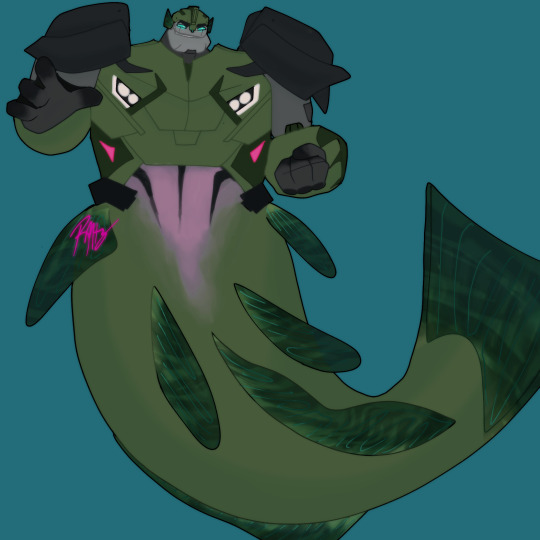


mermay pt 5: green humphead parrotfish bulkhead!
#tfp#bulkhead#transformers prime#maccadams#mermay#merformers#fishsticks au#art by rico#yall im so tired of drawings mers. BUT#i will keep posting fishsticks au content#not rn tho im gonna hibernate#(post art i drew in between the mermay stuff)#miko nakadai#almost forgot
706 notes
·
View notes
Text
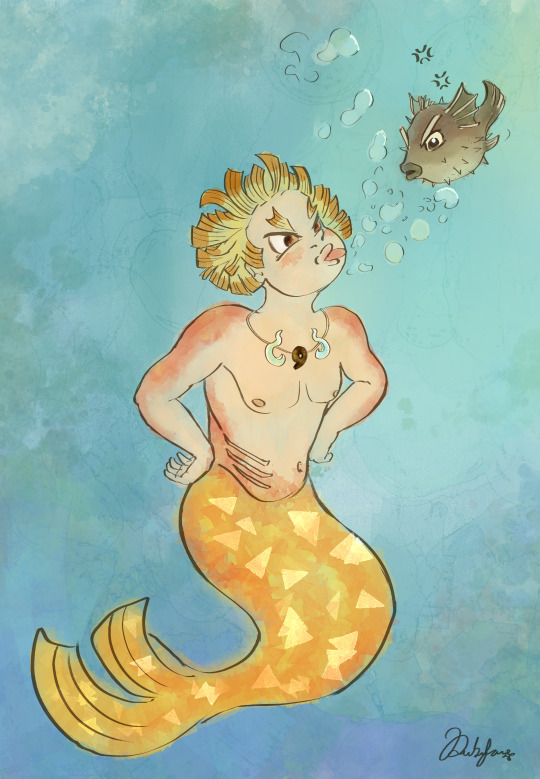
*Aggrieved pufferfish noises*
[Translators note: "You’re always whining about not wanting to go to work, you’re always hitting on girls, and you snore SO loud!"]
(no, I don't know what a pufferfish sounds like either)
____
Merman Zenitsu and pufferfish Chuntaro!
I was backing up some files earlier, and stumbled across this dumb AU doodle from a few years ago. Seemed appropriate to colour it with watercolours!
Cute little Chuntaro is a prickly pufferfish in this AU... but that raises the question: what marine species would the rest of the corps use to communicate underwater?
Swordfish are extremely fast swimmers, have convenient weapons/ letter clips stuck to their faces, excellent eyesight, are highly migratory loners with a massive range, and... ugh, fine. They're the obvious choice, aren't they?
Most members of the seaman slayer corps use swordfish.
Further fishy ideas beneath the cut:
Tanjirou:
My first instinct is to say sunfish, but the mental image of one of those massive creatures drifting menacingly behind him at all times is just too ridiculous.
And yet... somehow it makes perfect sense? A gentle giant that acts like a shield, patiently sheltering his sister from the sun whenever they travel near the surface.
Shinobu/ Kanao/Kanae: Butterfly fish, of course! All with polite and graceful personalities.
Shinobu fights using a variety of marine animal venoms including stonefish. Stonefish stings are treated with the applicaton of heat to denature proteins in the venom... so if Douma's an ice guy in this AU too, he's in for a rough time.
Inosuke: Briefly had a cute little pigfish, but he ate it within a day. Now he just has a regular corps- assigned swordfish. They're also tasty, apparently... if only he could catch it!
Tengen: Really wanted a Fireworks fish/ some other absurdly flamboyant tropical fish. Instead, he was assigned a bland- looking, tiny little fish that's well- suited to stealth missions.
It's been thoroughly ✨bedazzled✨by now and loves him. The most popular family member by far. Very plump and spoilt.
Gyomei: Green humphead parrotfish. These guys are massive, pretty docile, and spend most of their time crunching through rock- hard coral with big teeth to scrape off yummy algae, pooping out the rest as sand. They are cleaners that are instrumental in maintaining the health of coral reef ecosystems.
Gyomei's parrotfish is no exception; however, it used to be an insatiable glutton, to the point of destroying the coral reef it once resided in and being ostracised by its peers as a result. Wracked with guilt and with nowhere else to go, it received an invitation to serve in the corps. Its new master helped it learn self control.
Rengoku: There's no shortage of bold, flame- coloured fish species out there... but I reckon this guy just has the same generic swordfish species assigned to the rest of the corps. The only difference being that his used to be his father's loyal companion, and it's aged a bit, so it's not as speedy as it once was. It should've retired years ago, but refuses to abandon its self- imposed duty of keeping its master's son on the right path.
Was a rebellious playboy in its youth. Now it's a straight- laced military type, follows corps rules to the letter. Doesn't trust that slimy sea slug Nezuko one bit.
Sanemi: SAILFISH, hands down. Aggressive, vaguely wind- themed predator, and the fastest swimmer in the ocean. Both of them are pretty smug about that last point.
Genya: An archerfish would make sense thematically... but again, Genya just seems like another corps- assigned swordfish kinda guy to me? He definitely has a pet snapping turtle though. It's very small, and VERY grumpy.
Muchiro: A sweet natured blue- ringed octopus who wants nothing more than to be friends, but suffers from crippling social anxiety that makes it seem aloof and unapproachable.
Everyone is TERRIFIED of it except Tengen, who thinks it's flamboyant as heck, and Shinobu, who is simultaneously obsessed with it and wants to stab it dead.
Muchiro just ignores it, for the most part.
(Giyuu can relate).
Mitsuri: Blobfish lacking in self- confidence. Mitsuri thinks it's cute, and is absolutely correct in her opinion. Accepts cuddles from Mitsuri and Obanai only, and blushes at compliments. It's also insanely flexible, just like its master. Copes well under high pressure!
Giyuu: This man has a manta ray, no doubt about it. A creature of few words with a serene and peaceful disposition... yet inexplicably a huge social magnet that effortlessly draws everyone's attention (away from Giyuu). Especially popular with young merchildren, whom it often allows to ride on its back. Holds a deep respect for both its master and Urokodaki (who has a manta ray too, by the way).
Obanai: Had the toughest time deciding this one. A striped beakfish would match his colour scheme perfectly, but... I just don't think it suits him. A striped marlin, maybe? Anyone with more ideas, let me know!
Kaburamaru is a sea snake, obviously. A black- banded sea krait.
#This was hidden in one of my old uni lecture notes folders lol#was clearly paying attention that day#become a seaman slayer kids!#those evil humans are decimating the marine ecosystem with their overfishing!#ugh muzan as a random fisherman just isn't menacing enough though#he's a mutated freaky seamonster that attained the ability to walk on land maybe?#massive superiority complex over being “more evolved” than the merpeople#demon slayer#kimetsu no yaiba#zenitsu agatsuma#chuntaro#zenitsu#kny
20 notes
·
View notes
Text
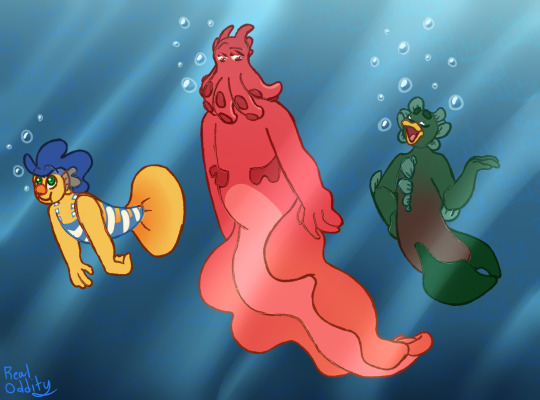
It's my first ever year of participating in mermay and the scrunklies were orbiting my brain so I had to make them aquatic.
Design notes below the cut :]
(rbs very appreciated <3)
So I chose some specific fish to merma-fy the boys into. For Yellow, a Royal angelfish
I made his markings look like his overalls because it felt odd leaving his body mostly yellow, and turned his hair into some fins!
I wanted to keep his palette contained to his regular palette, so I didn't add any black or indigo so it's not exactly a royal angelfish, but I am still happy with the results!

For Red, I just had to go for something tentacled, so I went with the Australian giant cuttlefish
I've always been a big sucker for cuttlefish and their highly interesting abilities, and as a gay fuck for Red fan of Red, I wanted to make him one. I was gonna go for not only an octopus, but also a more Ursula look. I opted out, though, as I realized I could give one uniform tail if I turned the cuttlefish's body(?) into a tail!
They aren't suckers, but I put little rough spots on his tentacles just to show some variation. I also snuck in some top surgery scars hehe.

And for Duck, while the idea of an emerald green cory catfish crossed my mind, I thought it was far too silly to not go with the Green humphead parrotfish!
Honestly I didn't do too much. Mostly turned his feathers into little fins and taking his coat color into a gradient on his tail. It's mostly just plain ol' Duck!!

I might do another one of these for Roy and Lesley because I got the idea of angler Roy but idk, I have a few other mermay schemes >:3c
#my art#dhmis#red guy dhmis#duck dhmis#yellow guy dhmis#dhmis fanart#dont hug me im scared#dont hug me i’m scared fanart#dhmis tv series#dhmis tv show#dhmis au#mermay#mermaid#mermen#merfolk#dhmis mermay#fluffybird#fluffybird dhmis#red x duck#its nothing overtly fluffybird but i just like signaling fluffybird shippers hehe#trans#gay#i could have drawn the water much better but didn't want it to overshadow the trio's colors#the sacrifices i must make#sorry for the spam btw#both tag and art spam lol#i just have been drawing a lot the past couple days
99 notes
·
View notes
Note
hello fellow fish liker (zohakuten), which do you prefer the snubnose pompano or the green humphead parrotfish
- fish anon i guess
“snubnose pompano, or Trachinotus blochii.”

#ask urogi#ask aizetsu#ask hantengu clones#ask karaku#ask sekido#aizetsu#karaku#kimetsu hantengu#sekido#urogi answers#👆🤓#🐟 anon
4 notes
·
View notes
Text
Fisherman's Log: 8/21/2023
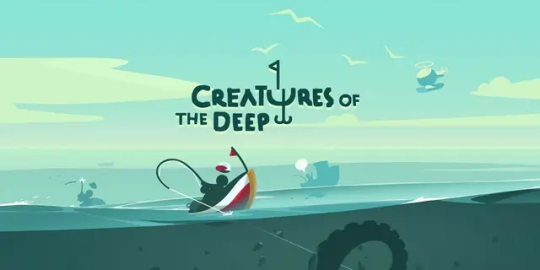
Uhh, hi! You probably don't know this, but I've been working on a long retrospective of Pikmin 4 as I play through the game. That was intended to be my first post on this blog. However, I quickly realized something: writing my thoughts about a game without exhaustively journaling my experience while playing it is excruciating. I grew up playing games for an audience, be it my mom watching me play some obscure Wii game, or me liveposting my playthrough of said game to whomever I was talking to on the Warrior Cats forums at the time. So, to remedy this, I'm going to be posting more hands-on "stream of consciousness"-type logs while I'm playing something. And what better to start with than a game I play very regularly: Creatures of the Deep.
A friend put me onto this quirky little game, knowing my propensity for fish and other aquatic creatures. It's been a fun little way to relax throughout my day, while also engaging my completionist hubris. I will confess: the reason I was iffy on posting journal entries alongside retrospectives is because I was feeling a bit of sunk cost fallacy. After all, if I've already completed a good bit of the game, why start now? But I'm nipping that in the bud. So! I'm going to catalogue my progress up until this point, then get into my daily session.
🗺️ Location Progress
Legend
⦾ Common
◈ Rare
✧ Epic
☆ Legendary
Please note that any inconsistent capitalization or spelling is just me noting things down exactly as the games have them written.
🏝️ Paradise Island 🏝️
41% | Discoveries: 36/37
🐟 Fish - 12/12
⦾ Bluefish - ★★★☆☆
⦾ Blue Trevally - ★★★☆☆
⦾ Bonefish - ★★★☆☆
⦾ Clownfish - ★★☆☆☆
◈ Green Humphead Parrotfish - ★★★☆☆
⦾ Largetooth Flounder - ★★★☆☆
⦾ Longtail Tuna - ★★☆☆☆
✧ Pacific Footballfish - ★☆☆☆☆
✧ Pelagic Stingray - ★☆☆☆☆
⦾ Snubnose Pompano - ★★☆☆☆
⦾ Spot-fin Porcupinefish - ★★★☆☆
◈ White Tuna - ★☆☆☆☆
🦐 Creatures - 5/5
⦾ Flower Tube Sea Anemone - ★★★☆☆
◈ Mimic Octopus - ★★☆☆☆
⦾ Peacock Mantis Shrimp - ★☆☆☆☆
⦾ Red Starfish - ★★☆☆☆
⦾ Sand Striker - ★★☆☆☆
🗑️ Trash - 19/19
• Can
• Can Fish
• Chest With A Skull
• Chips
• Empty Bottle
• Flip Flops
• Gear
• Kelp Leaf
• Key With A Skull
• Mask
• Message In A Bottle
• Old Phone
• Pinacolada Drink
• Plastic Bag
• Plastic Bottle
• Rubber Duck
• Sea Weed
• Straw Hat
• Wilson Ball
🏕️ Great Lakes 🏕️
41% | Discoveries: 62/63
🐟 Fish - 23/24
⦾ Alewife - ★★★☆☆
✧ American Eel - ★☆☆☆☆
⦾ Bloater - ★★★☆☆
⦾ Brook Trout - ★★★☆☆
⦾ Brown Trout - ★★★☆☆
⦾ Channel Catfish - ★★★☆☆
◈ Chinook Salmon - ★★☆☆☆
⦾ Coho Salmon - ★★★☆☆
◈ Flathead Catfish - ★★☆☆☆
✧ Goldfish - ★☆☆☆☆
✧ Lake Sturgeon - UNCAUGHT
◈ Lake Trout - ★☆☆☆☆
⦾ Largemouth Bass - ★☆☆☆☆
✧ Longnose Gar - ★☆☆☆☆
◈ Muskie - ★★★☆☆
⦾ Pink Salmon - ★★★☆☆
⦾ Redear Sunfish - ★☆☆☆☆
⦾ Round Whitefish - ★★☆☆☆
⦾ Sea Lamprey - ★★☆☆☆
⦾ Smallmouth Bass - ★☆☆☆☆
⦾ Walleye - ★★☆☆☆
⦾ White Bass - ★★★☆☆
⦾ White Crappie - ★★★☆☆
⦾ Yellow Perch - ★★★☆☆
🦐 Creatures - 9/9
⦾ Beaver - ★★☆☆☆
⦾ Bullfrog - ★☆☆☆☆
⦾ Chinese Mystery Snail - ★★☆☆☆
⦾ Common Musk Turtle - ★★☆☆☆
⦾ Eastern Massasauga Rattlesnake - ★★☆☆☆
⦾ North American River Otter - ★★☆☆☆
⦾ Quagga Mussels - ★★★☆☆
◈ Queen Snake - ★★☆☆☆
🗑️ Trash - 29/29
• Al'Capone Hat
• Arrow
• Baseball Hat
• Beaver Hat
• Beverage can
• Boom Floppy Disc
• Can Soup
• Chip Bag
• Cobra Sunglasses
• Colorful Headdress
• Concrete Shoe
• Fish Can
• Glass Bottle with XXX Sign
• Green floppy disc
• Grey Casette
• Hot Dog
• Meat Can
• Mouse Glove
• Old Branch
• Old Tire
• Pipe
• Plastic Bottle
• Toxic Barrel
• Treasure chest
• Vegetable Can
• Video Cassette
• Vinyl Record
• Wilted leaf
🌅 Costa Rica 🌅
27% | Discoveries: 41/62
I've elected to not list the undiscovered entries in Costa Rica and any future locations, as I prefer to go into newer areas as blindly as possible. For the Great Lakes, I already know the one fish I don't have is that damn sturgeon. I'd rather leave the rest up to mystery though.
🐟 Fish - 16/22
⦾ Barracuda - ★★★☆☆
◈ Blue Marlin - ★★☆☆☆
⦾ Broomtail Grouper - ★★☆☆☆
⦾ Cubera Snapper - ★★★☆☆
⦾ Dorado - ★★☆☆☆
⦾ Jack Crevalle - ★★☆☆☆
⦾ Pompano - ★★☆☆☆
⦾ Roosterfish - ★★★☆☆
⦾ Sierra Mackerel - ★☆☆☆☆
⦾ Snook - ★★☆☆☆
◈ Striped Marlin - ★☆☆☆☆
⦾ Tarpon - ★★☆☆☆
⦾ Tripletail - ★★★☆☆
⦾ Wahoo - ★☆☆☆☆
✧ Whitetip Shark - ★☆☆☆☆
⦾ Yellowfin Tuna - ★★☆☆☆
🦐 Creatures - 7/9
◈ American Crocodile - ★★☆☆☆
⦾ Brown Sea Cucumber - ★★☆☆☆
⦾ Nudibranch - ★☆☆☆☆
⦾ Olive Ridley Sea Turtle - ★☆☆☆☆
⦾ Pacific Land Crab - ★★☆☆☆
⦾ Pink Jellyfish - ★★☆☆☆
⦾ Yellow-Bellied Sea Snake - ★★☆☆☆
🗑️ Trash - 18/30
• Anchor
• Bicycle Frame
• Bikini Top
• Bottle Santa Maria
• Broken coral
• Chip Bag
• Coconut
• Costa Rican Vase
• Fish Can
• Flipper
• Oil Barrel
• Orange Cassette
• Palm Leaf
• Scuba Diver Mask
• Surfboard
• Volcanic Rock
• Watermelon Vinyl Record
• White Bottle
🏅 Achievements Board
Fish Catcher
★★☆☆☆
156/500
Explorer of Sea Creatures
★★☆☆☆
21/40
Recycling Master
★★☆☆☆
390/500
Trash Catcher
★★☆☆☆
66/100
Days in the Game
★☆☆☆☆
23/50
Master Reeler
★★☆☆☆
7/50
My fucking white whale.
Monster Hunter
★☆☆☆☆
1/10
Monster Collector
★☆☆☆☆
1/2
Tournament Lover
☆☆☆☆☆
0/5
Please don't make me use social functions I am just a humble fisherman
🎣 Fish Tank
I may very well make a spreadsheet for this in the future like some sort of deranged lunatic, but for now I just want to play the damn game so have some pictures.



I'm not sure what else to note. That I haven't bought any character customization yet? That all my stats are 1 except for Luck, which is 2? God forbid, my lure stats?? I don't know, but I'm done cataloguing! Now let's get into what you came here for!!
🗒️ Gameplay Log
📋 Info Board
- 4 reel in a row
Reward: +2 gems
- Catch 5 x Brook Trout
Reward: +500 coins
- Catch 3 x American Eel
Reward: +3 gems
Those gems are so, so valuable, so you know I'll be gunning for those. Although it does mean that I have to remember to play at night if I want to do that eel task. Those are kind of a pain in the ass... I should probably spend some time grinding garbage so that I can get Temporary Luck for eel time.
Well, first thing's first: off to Paradise Island to collect wood and see who our quest NPC is! As it turns out, Sir Joseph Bellywise is waiting for us, with a request for 3 Largetooth Flounder. That should hopefully synergize well with my consecutive reeling task.
I end up getting both tasks done without too much trouble, although I did break my reel chain and I don't want to talk about it. I handed in my three shittiest flounders for a nice 407 gold. I spend the rest of my visit hanging out in the Garbage Patch so that I can take home a full inventory and work towards that Temporary Luck. Once home, I quickly deposit two wood in the next section of the fish tank; that's where I'm focusing my efforts right now, as I've not found myself filling up the item storage yet. But with that, it's Great Lakes time!
Our daily NPC for this area is Mike "Lock" Smith, who just tells me to go fuck myself and that he's looking for someone more experienced. I'm level 7, what the hell do you want from me?! I also encounter some stress early on in the form of Sea Lampreys; the game doesn't recognize this, but I the player know that they're an invasive species, so morally I will not throw them back in to save bag space. Which means I may have to spend more gold going back to free up some slots.
...Or my rod could break and make us have to go back anyway. Neat. I'll plan ahead and go for the cheaper Garbage Grabber Rod; it shouldn't impede my catching too much, and I want to be able to hit a 50 cleanup streak by nightfall. The rest of the Brook Trout search is a cakewalk, but I swear the longer I know my reel streak is, the more scarcely I breathe during the hooking sequence. This is in spite of me purposefully not checking the number because I know it'll psych me out.
While I'm trying to catch one more thing to bring home, I wonder about the internal formula the game must use to calculate rod wear. I know for a fact different rods have different strengths, and I imagine that fish weight must factor in somehow, because some fish will be too strong and will pull the line out of range and break free. Does player strength get taken into account? I see people on the Discord saying that they still lose fish even at 8 or so strength. I don't know. Food for thought.
With the Brook Trout task now complete, I'm able to deposit a two-star into the fish tank, as well as adding some more wood onto the Alaska pile. Seeing as how I've not unlocked that area yet, building that section of the fish tank is not a priority. But I do need something to do with all that wood.
Since our final daily task is locked to nighttime, and I'm writing this at 3:15 pm, that means our last stop for now is Costa Rica! I'll be honest, this map is so huge, I don't even end up finding all the daily wood half the time, and I don't exactly bother. It's just sooo much effort to comb through all that water... based on the size progression so far, I can only imagine Alaska will be downright nightmarish.
I immediately eat my words and find two wood floating right next to each other.
While it's a nice bonus for sure, this still leaves me in the dark on who and where our Daily Slut Encounter is. I eventually give up and bring home some dudes for the tank: a Tarpon, a Jack Crevalle, and a Pompano, all sadly one star. The Tarpon has just the most delightfully smug little face swimming around in there.
I returned to Costa Rica to try and find some new trash, and only on my last bag slot did I snag something new: the Ship Bell from Santa Maria. It's only on the way back that I finally find the NPC. It's Sir Joseph Bellywise again, this time wanting 110 lbs of fish for a party tomorrow. I can do that! After I go drop off this trash run. Self-reminder: he is west of the Spanish Shipwreck. Trash payouts barely make up for the price of coming back, but I need it.
Aand it turns out the task's payout was barely worth the trip anyway! 95 coins for 110 pounds of fish? That is straight up daylight robbery. Anyway, after brutally murdering my reel streak, I don't feel like playing anymore, so I'll resume this entry tonight when it's eel time. I place a one-star Broomtail Grouper face-down and end my turn.
𓆝 𓆟 𓆞
Touching base again past midnight, and holy shit, I was actually able to do it! While I was waiting for my T gel to dry, not only did I snag 3 American Eels and claim the gem prize, but I also caught the Lake Sturgeon (2 stars, straight to the fish tank) and got 5 more gems from Aneta Angler for completing the area! I also slapped a 2-star American Eel and a 1-star Flathead Catfish into the fish tank for good measure. With time left on my Temporary Luck, I set out for the Great Depths of Costa Rica.
And I sure reaped the benefits! I brought home a 2-star Barracuda, a 2-star Wahoo to replace the one in my fish tank, a 2-star Nurse Shark, a 1-star Hammerhead Shark, and a 1-star Whitetip Shark. In other news, I need to do wrist stretches now. I also got myself a new creature discovery in the Red-Ringed Clinging Crab; all in all, this netted me another Aneta Angler prize, with her giving me 5 Rare Bait for my efforts. The payout for this trip wasn't spectacular, but it'll be worth it in the future.
... And dear God, to ride out the last of my Temporary Luck, I hit the middle north of Paradise Island, as that's where other anglers on the Discord had been reporting Shredder sightings for tonight. And whaddya know! I actually caught the fucker first try! This got me two stars in the Monster Collector achievement, and I can finally go talk to Cap'n Slappy and finish out the main area quest. I also level up, getting 2,800 coins in all between that and the quest reward. ...Tapping the level-up turns out to be a major mistake, as I was planning on going to sleep, but now I have an hour of temporary luck. e.e I spend my singular stat point on Strength, boosting it to 2; I've been searching for a lot of large targets, and every time a fish breaks free, I lose a bit of my awake time for the day.
Well, I'm not one to waste Temporary Luck now that I'm journaling my grind, so back to Costa Rica it is. I can't tell if this is just copium on my part, but I swear there is an immediate, noticeable difference in how easy it is to control the reel bar when battling a fish that engages the minigame now that I've leveled up my Strength. Either that or I'm getting better at the game, which is also true, but I swear that bar is just steadier. Honestly, I was considering getting a Monster Rod, but I've been doing so well with just the Carbon Rod that it feels unnecessary at this point.
I'm glad to announce that I got even more new discoveries before bed: the Pacific Sailfish (2 stars) and the Bull Shark (also 2 stars). I was trying for the Black Marlin for a bit, but with a sliver of Temporary Luck left, I decided to call it quits because I was getting too eepy. Still, I'd say that was a relentlessly productive day of fishing.
This was really fun to journal! The verb tenses are all over the place, and punctuation is real funky; this certainly isn't editor's portfolio material. But I think it's something I'd like to do more often! I like writing more than I give myself credit for. Hopefully the next post will be much shorter!
2 notes
·
View notes
Photo
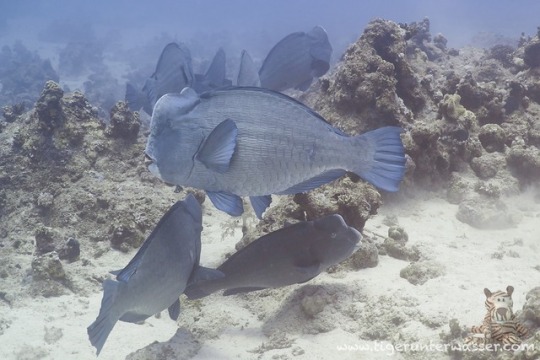



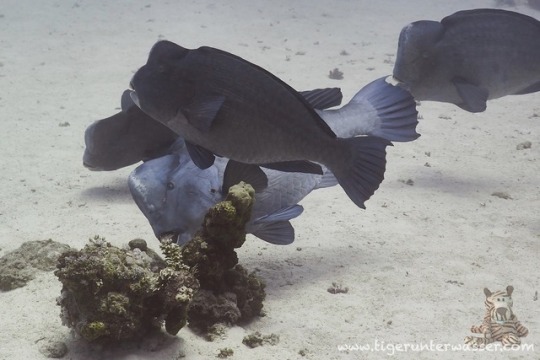
05.09.17
Büffelkopf Papagaifisch / green humphead parrotfish / Bolbometapon muricatum / Abu Ramada Süd - Hurghada - Red Sea / Aquarius Diving Club
#Büffelkopf Papagaifisch#green humphead parrotfish#Bolbometapon muricatum#Abu Ramada Süd#Hurghada#red sea#Aquarius Diving Club#scuba diving#diving#Tauchen#plongée#duiken#sea#sea life#underwater#Unterwasser#marine life#Ägypten#Egypt
10 notes
·
View notes
Note
Gaud PLEASE google image search the green humphead parrotfish. PLEASE.
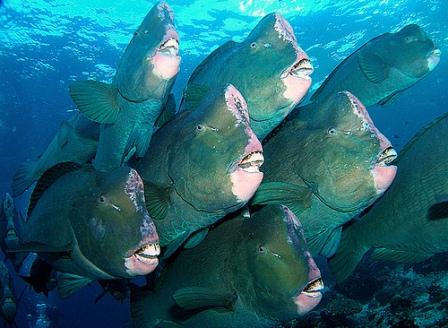
betrayed by my own unquenchable thirst for bad knowledge
6K notes
·
View notes
Text
Pacific Remote Islands Marine National Monument celebrates its 10th Anniversary

The shallow waters and forest of Palmyra Atoll with the text, “Monument[al] Stepping Stones”. Photo by Kydd Pollock
Comprising some of the most isolated, oldest, and healthiest atolls, reefs, and islands, the Pacific Remote Islands Marine National Monument (the Monument) is home to a vibrant underwater and terrestrial world. Although the Monument is pocketed around the central Pacific Ocean, it is the most widespread collection of coral reef, seabird, and shorebird protected areas under a single nation’s jurisdiction. These marine and terrestrial refuges sustain many endemic species of corals, fish, seabirds, insects, and vegetation not found elsewhere.
On January 6, 2009, the Pacific Remote Islands Marine National Monument was established, surrounding the areas of: Howland, Baker, and Jarvis Islands; Johnston, Wake, and Palmyra Atolls; and Kingman Reef. We celebrate its 10th anniversary this year and all that the Monument has taught us.
Each land area tells of a unique history in geology, biology, and human history.
The seven atolls and islands included within the Monument are farther from human population centers than any other U.S. area. Though they are remote from humans, they are vital nesting habitat for millions of seabirds and resting habitat for migratory shorebirds. These low-lying islands host up to 15 different breeding seabird species. Some colonies are large enough to be of international significance.

A map of the Pacific Ocean showing the 4 Marine National Monuments in relation to each other, including PRIMNM. Graphic by Holly Richards / USFWS
Long after seabirds and marine mammals had been using these remote islands as stepping stones for their next destination, early Polynesian voyagers stopped here as well when exploring the Pacific. It is known that Wake Atoll is an important cultural site for Marshall Islanders.
Several of the islands were annexed by the United States in the 1850s under the Guano Islands Act. The establishment of trans-Pacific air routes and territorial disputes led to official colonizing efforts by the US in the 1930s under the American Equatorial Islands Colonization Project. In 1935 the US occupied and reclaimed Howland, Jarvis, Baker, and other Pacific islands by sending young men who were mostly Native Hawaiians (now known collectively as Hui Panalā‘au) to construct settlements. In fact, the men on Howland were the ones who prepared for Amelia Earhart and Fred J. Noonan’s flight landing in 1937! However, radio contact was lost and Earhart’s plane never arrived: her fate still unknown.

The Earhart Light day beacon on Howland Island at sunset. Constructed by the Hui Panalā‘au and named in Earhart’s honor. Photo by USFWS
On December 8, 1941, a day after Japan’s attack on Pearl Harbor, the Pacific Island territories were also bombed. Two men were fatally wounded on Howland Island and the rest of the members of Hui Panalā‘au were evacuated in 1942. The contributions and sacrifices made by Hui Panalā‘au established these islands as part of the United States, thus setting the stage for their conservation status as National Wildlife Refuges and Pacific Remote Islands Marine National Monument today.
The emergent lands at Johnston and Wake Atolls remain under the jurisdiction of the U.S. Air Force, but the submerged lands and waters out to 12 nautical miles are protected as National Wildlife Refuges. Important restoration work has been conducted for the preservation of wildlife and habitat on many of these refuges: including work towards eradicating the invasive yellow crazy ants on Johnston, the invasive rats on Palmyra, along with the removal of military debris from all of the islands for native habitats and species.
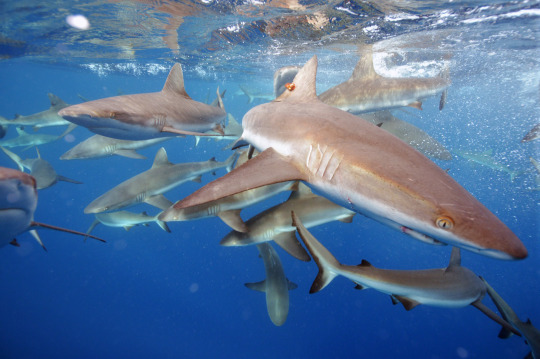
Several grey reef sharks swimming close to the top of the water’s surface at Palmyra Atoll National Wildlife Refuge. Photo by Kydd Pollock
These interconnected refuges are key stepping stones for the colonization and dispersal of species across the Pacific Ocean.
The threatened green and endangered hawksbill sea turtles, pearl oysters, giant clams, reef sharks, coconut crabs, groupers, humphead and Napoleon wrasse, bumphead parrotfish, spinner dolphins, melon-headed, beaked, and humpback whales - all and more are found within the Monument. Their abundant populations contrast with other areas where they are greatly depleted; many nationally and internationally threatened, endangered, and diminished species thrive in the refuges of the Monument. Their history and current presence is what we aim to protect, as the Monument contains some of the oldest and most isolated atolls and reefs.
But what makes these islands and atolls specifically unique? Here are some quick facts about them that no other place can boast:
Johnston is an ancient atoll, one of the oldest in the Pacific alongside Wake, which is the oldest living atoll in the world!
Wake Island is a National Historic Landmark for the preservation of sites and artifacts from WWII in the Pacific and the transpacific aviation era prior to the war.
The Monument’s protected waters hold corals that are up to 5,000 years old and as many as 418 fish species and over 180 coral species (at Kingman Reef and Palmyra): numbers that are the highest in the central Pacific.
Kingman Reef is known to be the most undisturbed coral reef within the U.S., containing a greater proportion of apex predators than any other studied coral reef ecosystem in the world.
Expansive shallow coral reefs and deep coral forests at just Howland, Jarvis, and Barker Islands teem with a fish biomass double than that found in the Hawaiian Archipelago.
Palmyra Atoll consists of over 26 islets, many covered in Pisonia grandis forests: one of the best and last in the Pacific. These tropical trees provide habitat for 11 species of seabirds, including one of the largest red-footed booby colonies in the world and the largest black noddy colony in the Central Pacific.
youtube
A video showing the deep water of Johnston Atoll. Entitled “Forest of the Weird,” it shows a landscape of almost entirely tall glass sponges. Video by National Oceanic and Atmospheric Administration Office of Ocean Exploration and Research, 2017 Laulima O Ka Moana
Because these atolls and islands are far from population centers and direct human impacts, we can gain knowledge from these protected waters to improve coral reef management in other areas. They are ideal “laboratories” for assessing the effects of climate change. Baker, Jarvis, and Howland islands afford unique opportunities to conduct climate change research at the equator: their coral skeletons recorded the earth's climatic history for millennia! And by protecting the Monument, future generations of Americans will still have the opportunity to sense the wonder of nature in the heart of the Pacific.
Want to Know More About these National Wildlife Refuges (NWR)?
Here are more links to describe what it’s like to visit: Jarvis and Palmyra
Take a virtual dive at Palmyra!
Here are more links to photo albums of the different NWR:
Pacific Remote Islands Marine National Monument
Palmyra Atoll NWR
Kingman Reef NWR
Johnston Atoll NWR
Baker Island NWR
1 note
·
View note
Photo

Green Humphead Parrotfish #naturetheogmeangirl
77 notes
·
View notes
Photo

@ODUFishing: TheIGFA: Last year on this day, Leon Mark Weeks caught this incredible 46.35-kg (102-pound, 3-ounce) green humphead parrotfish to set the new IGFA All-Tackle World Record. He was fly fishing the flats of Providence, Seychelles, and landed and released th… https://t.co/hACrHsBm5d
0 notes
Photo

Do you know? The green humphead parrotfish is the largest species of parrotfish, growing to lengths of 1.3 m and weighing up to 46 kg. . . . . . . . . . . . #greenhumphead #humpheadparrotfish #parrotfish #freediving #diving #lovely #lovelytravel #perhentian #perhentianisland #island #beach #travelmalaysia #backpackmalaysia #malaysia #terengganu #besut #jetty #ootd #potd #nature #life #love #relax #yolo #malaysiaisland #photography #insta #instagood #instaday #instagram https://www.instagram.com/p/BvSiJi8BrFz/?utm_source=ig_tumblr_share&igshid=2jdyocay0t6s
#greenhumphead#humpheadparrotfish#parrotfish#freediving#diving#lovely#lovelytravel#perhentian#perhentianisland#island#beach#travelmalaysia#backpackmalaysia#malaysia#terengganu#besut#jetty#ootd#potd#nature#life#love#relax#yolo#malaysiaisland#photography#insta#instagood#instaday#instagram
0 notes
Text
Diving Australia’s Hidden Gem: Rowley Shoals
Everyone knows Australia for the iconic Great Barrier Reef. But Western Australia is home to the country’s best-kept diving secret: Rowley Shoals. The shoals have one of the shortest dive seasons running only from September through December, meaning fewer than 200 people dive this isolated and pristine location each year.
Rowley Shoals
The Rowley Shoals Marine Park lies 186 miles (300 km) off Broome, Western Australia. Consequently. it remains one of the most remote and pristine marine environments in the world. The shoals consist of three coral atolls at the edge of the continental shelf. It’s a stunning location for a dive safari, with 360-degree views of turquoise waters and almost no other vessels or people in sight.
The best Rowley Shoals dive sites
Dives sites at Rowley Shoals offer something for everyone and the diving is suitable for novice and experienced divers. A minimum of 10 to 20 logged dives is usually required.
Rowley Shoals offers pristine coral-reef diving, mostly as wall and drift dives. The best dive areas include:
Mermaid Reef
Northeast of Rowley Shoals, Mermaid Reef is part of the Mermaid Reef National Nature Reserve. It rises from over 1,300 feet (400 m) and features a crystal-clear lagoon surrounded by corals. Sailfish and humpback whales visit the outer sections of the reef and there are numerous corals, giant gorgonian fans, and plenty of fish species about as well. Mermaid Reef has strong tidal flow and currents and features exciting drift dives from outside the atoll into the lagoon.
Vee in the Wall and Odyssey Alley are both on the outer sections and offer fantastic reef- and deep-blue diving. Cod Hole (not to be confused with the dive site of the same name on the Great Barrier Reef) is the place to dive with giant and friendly potato cod. Northern Wall is one of the world’s best dives, featuring a steep drop to 262 feet (80 m), and is home to numerous species of reef fish.
Clerke Reef
Named for Captain Clerke, who first spotted the reef in the 1800s, this reef features a shallow lagoon ideal for snorkeling. There are abundant corals and a variety of marine life. The Aquarium dive site in the lagoon offers easy diving in warm, calm waters.
Clerke Reef also has fantastic wall diving on the outer sections of the reef. Here you’ll find hundreds of fish and coral species as well as gray reef sharks. The visibility often reaches 164 feet (50 m) and divers should keep their eyes peeled for giant clams up to 5 feet (1.5) meters long. Jimmy Goes to China dive site is famous for curious reef sharks and pelagic species cruising along the wall, which is covered in gorgonian fans and black corals.
Rowley Shoals has a wide tidal range, resulting in exciting drift dives. The Rollercoaster is a great example of this and pushes divers through Clerke Reef channel. Fans of adrenaline-filled drift diving will not be disappointed.
Marine-life highlights at Rowley Shoals
Rowley Shoals is quite biodiverse, with more than 200 species of coral and 700 species of fish, many of which do not live to shore. Residents of the reefs include coral trout, clownfish, humphead parrotfish, Maori wrasse, Spanish mackerel, giant potato cod, dogtooth tuna and green turtles. Divers can swim among schooling trevallies and spot a wide variety of sharks, such as whitetips, blacktips, silvertips and even occasional hammerhead and tiger sharks.
The shoals are not a critter-diving destination as such, but there are plenty of nudibranchs and small stuff to keep fans of small marine life satisfied.
Other area activities
Broome is a popular holiday gateway to the Kimberley region and the area has a variety of highlights, including dinosaur tracks in the rock at Gantheaume Point, the white sands of 13-mile (22 km) Cable Beach and Broome’s famous pearl farms. There are also a handful of Kimberley adventure cruise ships that visit the waterfalls, beaches, gorges and mountains of this wild region.
When to visit
The best time to visit Rowley Shoals is between September and December. Since liveaboard diving is the only way to explore these reefs, early booking is best.
The MV Odyssey and True North liveaboards are the main vessels that visit Rowley Shoals. The MV Odyssey catamaran caters for up to 20 guests and offers 7-night Rowley Shoal safaris.
Getting to Rowley Shoals
Broome is the most common departure point for Rowley Shoals liveaboard safaris. It’s easily accessible via Perth, which has international flight connections from around the world.
Divers and writers at LiveAboard.com contributed this article.
The post Diving Australia’s Hidden Gem: Rowley Shoals appeared first on Scuba Diver Life.
from Scuba Diver Life https://ift.tt/2Suspid
0 notes
Text
Diving Munda Wrecks and Reefs
What do you like to see when you dive? Big stuff? Macro? Pretty reefs? Or is it wrecks? Before I visited Munda in the Solomon Islands, I would not have called myself a wreck diver. I think of wrecks as dark, rusting constructions devoid of life. They’re interesting to history buffs or divers who like to push limits — or so I thought. Diving Munda wrecks and reefs changed these preconceptions.
Like much of the Solomon Islands, Munda is a tropical paradise; a lush, green island surrounded by turquoise lagoons and coral reefs. But the legacy of WWII is never far away, present above and below water, and perhaps no more so than in Munda. Here there are reefs and wrecks. And the wrecks, just like the reefs, are teeming with life.
Diving Munda wrecks and reefs
I came to the Solomon Islands for its incredible marine biodiversity. I’ve dived here before and had a small taste of its busy coral reefs, which left me hungry for more.
The Solomon Islands sit on the eastern edge of the Coral Triangle, the global epicenter of marine biodiversity. This area spans over 2.3 million square miles (6 million square km), encompassing Indonesia, Malaysia, the Philippines, Timor and Papua New Guinea. An astonishing 76 percent of the world’s coral species live here, along with six of the world’s seven turtle species and over 2,228 species of fish.
On my first plunge into Rendova Lagoon it seems like they’re all here right now in Munda. I don’t know where to look first.
The reef wall at Shark Point, our first dive, is covered in corals of all shapes, sizes and colors. Soft corals, whips and sea fans make way for hard, branching corals and moon-shaped brain corals. Flitting among them are thousands of butterflyfish, damsels, angels, anthias and surgeons. Anemones stand by with their resident anemone fish on guard. Out in the blue big schools of snapper, bluefin trevally and barracuda circle.
Our second dive at nearby Munda Reef offers a similar scene. This time a few reef sharks also join us along with some blue-spotted rays. Huge schools of scissortails and fusiliers whoosh past between us.
Wreck diving in Munda
If it were up to me, I’d come back to these same two dive sites every day for the duration of our stay, but our guides from Dive Munda have different ideas.
First, we visit Haipi Reef, about a 30-minute boat ride away. The variety of corals here equals the variety of reef fish. A few humphead parrotfish join us for the dive and we share our safety stop with huge schools of butterflyfish and damsels.
When we surface, our guides tell us our next two dives are wrecks. I’m not thrilled, but since I’ve enjoyed every dive so far, I’m not expecting to be disappointed. It’s these two dives that change my mind about wrecks.
The wrecks are both American fighter aircraft, the first a Bell P-39 Airacobra. This was one of the principal American fighter craft in service when the United States entered WWII.
It’s sitting on a white, sandy bottom and it’s mostly intact. But that’s not the first thing I notice — what I notice first is that I almost can’t see it for all the fish.
Large schools of juvenile fish surround the plane, and when I get close enough, I see it’s full of them as well, along with hundreds of colorful shrimp. The body of the plane, what I assume was once painted a drab gray, is now painted in colorful corals which create gorgeous patterns along the length of the plane.
The second wreck is the Douglas SBD Dauntless, sitting on a sandy bottom in very shallow water. Soft and hard corals, teeming with life, cover the wreckage. And this one has an interesting story.
Our dive guide tells us that he once took a retired American pilot diving here, the very same pilot who was flying the plane when it was shot down. Even more remarkable is that a short time later, the guide took a Japanese man diving here as well, one who claimed to have shot down the plane during the war.
According to our guide, the pair met up back in Honiara and have remained in touch. While I’m not sure how much of the tale is true, I began thinking about the stories and people behind the many other wrecks in the Solomon Islands. And, as a once disinterested wreck diver, Munda made a believer of me.
As of June 1, 2018, Solomon Airlines is offering non-stop roundtrip flights from Brisbane directly to Munda, making arrival and departure that much easier. Check the website for details.
The post Diving Munda Wrecks and Reefs appeared first on Scuba Diver Life.
from Scuba Diver Life https://ift.tt/2CZJxbf
0 notes